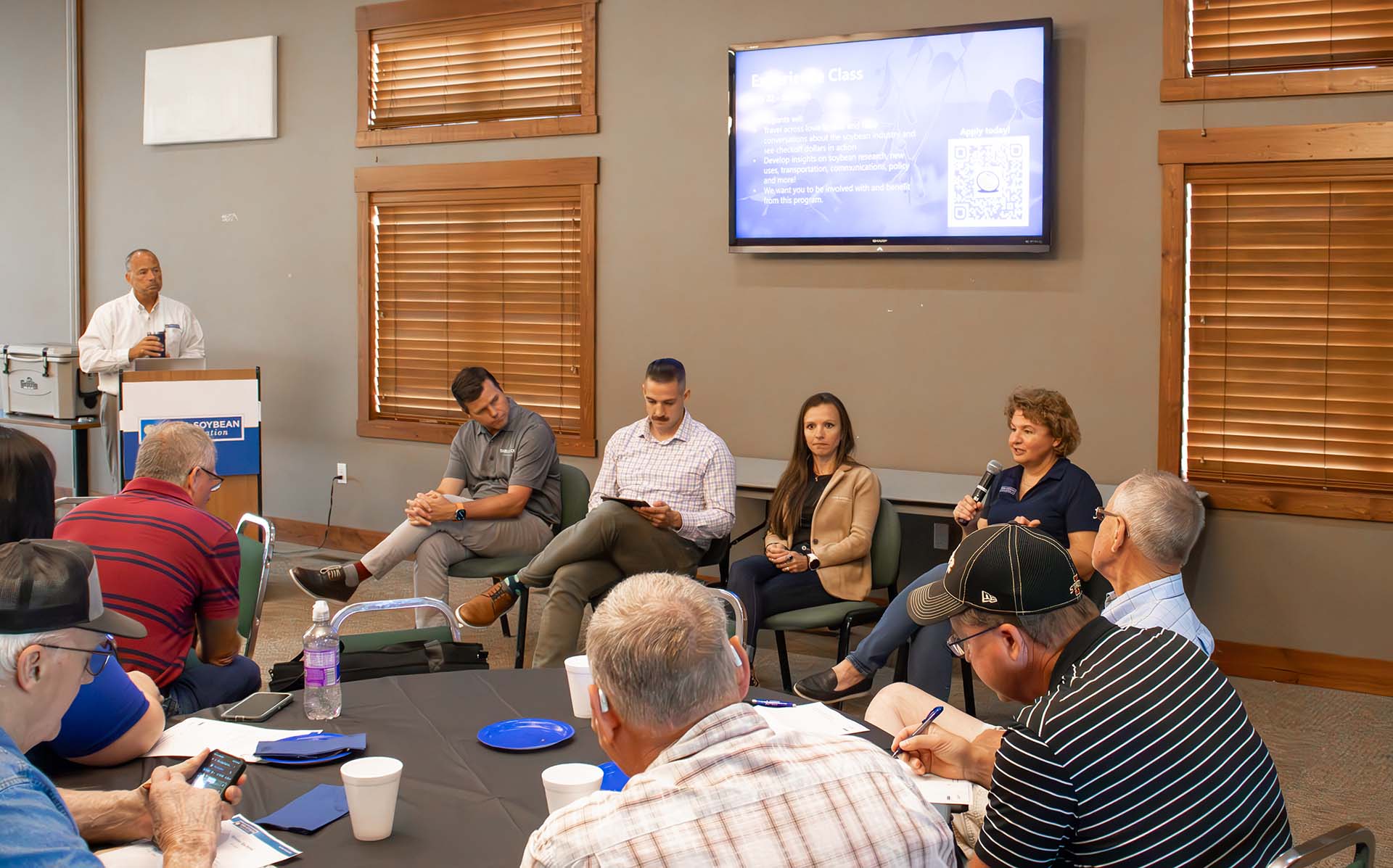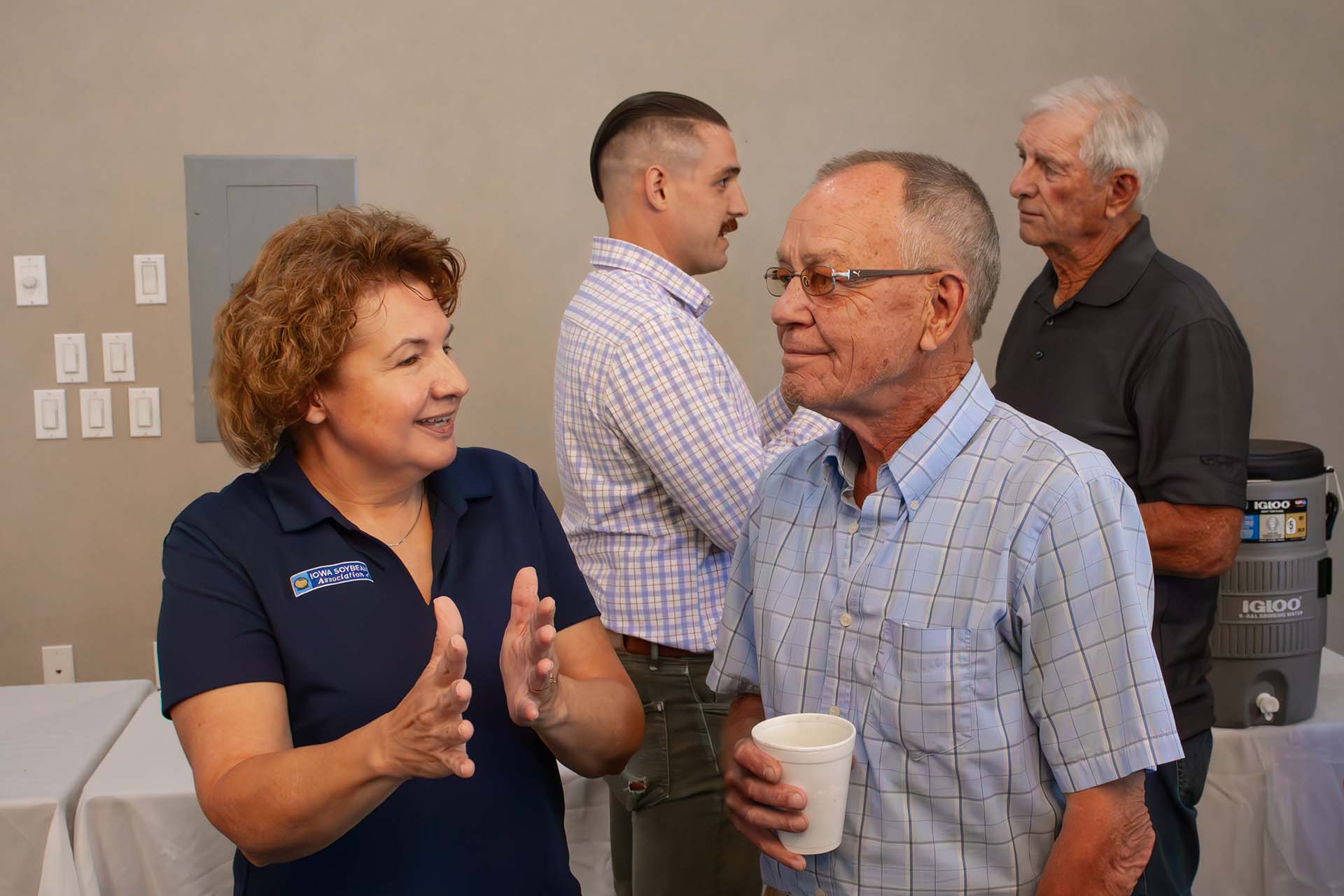
(Photo: Iowa Soybean Association / Jeff Hutton)
Regulations, research, economy top Summer Soy Series topics
June 27, 2024
What are the issues soybean farmers are facing today? What does the future hold?
The Iowa Soybean Association (ISA) invited farmers, industry experts and ISA leadership to share in that discussion during this week’s ISA’s Summer Soy Series.
Everything from farmer profitability, productivity and sustainability to soybean demand, research, policy and more were on the table during the four meetings held across the state (Manchester, Fort Dodge, Williamsburg and Osceola).
What’s important
In Manchester, panelists shared their thoughts on topics with farmers and others gathered for the event.
Aaron Putze, chief officer of strategy and brand management at ISA, posed the question to the panelists about what they believe in of the upmost importance right now for soybean farmers.
Corey Jorgenson, the CEO of Shell Rock Soy Processing, says much of the focus now is on the investments that have been made in soy crushing facilities in an effort to produce renewable energy resources.
However, he says everyone in the soybean industry must understand that while expanded crush capacity is increasing soybean oil supplies, it is far above the Environmental Protection Agency’s Renewable Volume Obligation (RVO).
According to the U.S. Department of Agriculture (USDA), the crush capacity allows for an increase soybean oil supplies by about 5.5 billion pounds – that translated into about 700 million gallons of renewable diesel – much higher than the EPA’s RVO of about 200 million gallons.
Jorgenson says what’s missing is that the added production of soybean meal continued to be emphasized and marketed to help feed domestic and global consumers.
“Energy and agriculture are working hand in hand to answer these food and energy needs,” he says.
ISA President Suzanne Shirbroun agreed.
She says her recent trip to Colombia highlighted the value of U.S. soybean products, like soymeal, to consumers there.
“They are so appreciative of the quality of the products we deliver, whether it’s the whole bean or soybean meal,” Shirbroun says. “They understand quality and what it does for their livestock, primarily poultry as well as swine. When they use U.S. soy, their animals grow better, whether it’s fish, poultry or hogs”
Shirbroun also noted that during a recent trip to Romania, she visited a vertically integrated poultry facility.

Talking to the buyers there, they said they were primarily using soybeans from Ukraine and South America.
But Shirbroun says the organization’s head nutritionist insisted that U.S. soybeans were a much better product than other foreign competitors and said it had been 20 years since the last time they purchased American soy products.
“By the end of the visit,” Shirbroun says. “We’re hoping that we will be able to get some U.S. soy into that operation. We have a great reputation across the globe because (foreign markets) know we produce great soybeans.”
Farm bill and trade
Matt Herman, ISA’s chief officer for demand and advocacy, says getting more U.S. soy to foreign markets through trade is important, but much of those efforts is dependent upon the establishment of a new farm bill.
“Farmers are still waiting on a farm bill and we’re staring down the prospect of not getting that for another one to two years,” he says.
Herman says if Congress doesn’t reach any consensus before the fall election, chances are a lame-duck session won’t likely produce any results either.
“We’re concerned that if we don’t have a farm bill, when it comes to exports, how do we move soybean meal to different buyers?” he asked.
Through ISA non-checkoff efforts, Herman added that ISA has been asking Congress and the administration to double its foreign export trade programs, noting that a farm bill is critical to opening up more markets.
“On the advocacy side of ISA, we need to re-engage on trade, in partnership with our demand side,” he says. “We need to start to drive this conversation with the administration and future administrations.”
Value in research
Christie Wiebbecke, ISA’s chief officer for research and conservation, says her team is focused on three things – productivity, profitability and sustainability.
“You can’t to the last part without the first,” she says. “We always want to tie back to the return on investment (ROI) for our farmers, making sound investments that improve the bottom line.”
During last week’s ISA board of directors meeting, Wiebbecke says the biggest concern from farmer-members was that while research trials and other efforts are important, how does that translate into what needs to happen on the farm?
“It’s great to know about insect pressures or new diseases, but the question from our farmer leaders was, ‘What do I do about it?’ ” she says. “There’s a gap into translating that research and putting that science into action.”
Wiebbecke says ISA wants to take innovative ideas and make them work for farmers on the farm.
“How do we take those ideas to the farmers and how do we implement that on the farm and make it productive, profitable and sustainable?”
While ISA farmers-members are committed to research projects and trials, like cover crop studies, ISA, university researchers must translate that research into action.
ISA Conservation Agronomist Matt Swanson added that there’s a lot of excitement surrounding the research that has been conducted and is ongoing on issues like the use of cover crops. The information, he says, hopefully will allow farmers to determine what might work best for them on their fields.
Meanwhile, ISA Research Agronomist Shane Beck emphasized that ISA is “very independent. We’re not trying to sell you something. We want to let farmers know what we’re seeing out there and that we’re open to working with you.”
Wiebbecke says it’s important for soybean producers statewide to know that ISA is ready to work with them on any issue they might encounter in their fields.
“We’re here to serve you,” she says.
Using checkoff dollars wisely; taking action
Shirbroun told audience members that she’s proud of the diverse 22 farmer-members that currently make up the ISA board.
She pointed out that there are board members in their 30s, while other farmers have been farming for more than six decades. She noted they have diverse operations and a myriad of ideas they bring to the table.
But they all agree that they want to make effective use of soybean producers’ checkoff dollars, making sure that there is improved demand across Iowa, the United States and the world.
And not every program or research project, Shirbroun says, is funded.
“We cannot fund all the proposals,” she says. “We look to fund what will be the best return of our dollars.”
She says the board agreed with Wiebbecke that research proposals must yield action if there is any money spent.
“On the supply side, we were a little disappointed with some of the results,” she says. “Some of the research proposals were not funded because they are not meeting our farmers’ expectations.”
SAF
Herman addressed questions surrounding the future of Sustainable Aviation Fuel (SAF) and potential tax credits.
He says with the 2022 Inflation Reduction Act, there was an indication from the government that tax credits might be in play for those up and down the supply chain in regard to fuel produced from soybeans and corn.
Herman says tax credits would be issued to those that allow for “planet-smart practices” like no-till, strip-till and cover crops.
But because of the way the rules have been initially written, farmers cannot earn those credits without implementing all of those practices – they can’t pick and choose practices à la carte.
“In talking with the USDA, we appreciate this voluntary program, but quite frankly, implementation is impractical for many swaths of the country,” Herman says.
On the soybean side right now, he added, there’s doesn’t seem to be much value in prospect until the administration, Congress and others can definitely outline what will work for farmers hoping to cash in on SAF credits.
Jorgenson says it’s clear SAF, biodiesel and other renewable energy demand will continue to grow, but it’s a matter of subsidies and policy that will help drive the overall economics and profitability for soybean producers.
Economic outlook
During the meeting, Nick Repke with Kluis Commodity Advisors, shared some thoughts on the farm economy.
He says history shows that fundamentals are “bearish” when prices are trending lower.
Repke says some examples that farmers could see:
- USDA projections for record yields fall short: “Acreage” report number shows more prevent plant.
- Trend of crop conditions in July and August which will indicate projected yields.
- Weather in July and August that will impact yields.
For grain markets, Repke pointed to three possible scenarios:
Scenario #1: Ideal weather going forward. Trending yields for soybean at 52 bushels per acre (bpa)
- Less likely and will require a later fall harvest.
- Soybeans fall to a low of $10-$10.50 per bushel between August and October.
Scenario #2: Good but not ideal weather. Soybean yields 50 bpa.
- Soybeans fall to a low of $10.50 to $10.80 per bushel between August and October.
Scenario #3: Hot and dry weather in July and August. Yields fall with soybeans at 49 bpa or less.
- Soybeans rise to a high of $12.50-$14 per bushel between August and December. Expect an extreme market inverse to develop.
Repke also pointed to the USDA’s acreage report, slated to come out this Friday, as one indicator to the overall numbers for soybean producers to consider.
Other issues
Herman says there are other issues that ISA is watching including the advancements in technology for industrial uses.
He pointed to the development of a firefighting foam from soybeans because it’s yet another way for soybean producers to get their products to market.
Shirbroun says while opportunities are potentially plentiful for soybean farmers, regulations can be a thorn in the side of progress.
She says the EPA’s Endangered Species Act and what it might do to restrict farmers on their practices is concerning.
“It’s frightening what the EPA could do to us and we need to be top of that,” she says. “If the EPA has its ways, we will not be able to farm the way we do now. Every square inch of Iowa farmland will be impacted.”
It’s important that farmers advocate and educate politicians, the EPA and others as to how regulations can negatively impact producers in the fields.
Herman agreed, saying advocacy from all farmers to their legislators in D.C. and Des Moines is paramount to the overall success of the industry.
“ISA needs to hear from you, and we can help facilitate that message,” he says.
Tom Vaske, an ISA farmer-member from the Manchester area says the information provided this week during the summer soy series was important for him to hear.
“There was a lot of good information,” he says. “My biggest concern was the Endangered Species Act comment. I didn’t realize what was going on. It’s a big deal, all of these regulations, because it has a direct impact on me and the way I farm.”
Vaske, who raises soybeans and corn on 1,100 acres says the summer soy series was a great opportunity to hear from those in the know.
“Regulations are the biggest concern for me because too often decisions are being made by those who don’t understand agriculture.”
Back